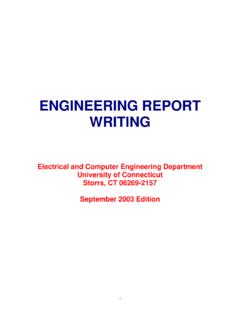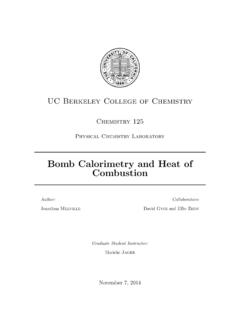Transcription of Inductively Coupled Plasma-Atomic Emission Spectroscopy
1 UC Berkeley College of ChemistryChemistry 105 Instrumental Methods in Analytical ChemistryInductively Coupled plasma -AtomicEmission SpectroscopyShort ReportAuthor:JonathanMelvilleLab Partners:JakePrecht, PhuongTran, and JeremyHsuGraduate Student Instructors:RichardCooper& DanielMortensenApril 9, 20141 TheoryICP-AES, or Inductively Coupled Plasma-Atomic Emission Spectroscopy (also knownas ICP-OES, Optical Emission Spectroscopy ), is a type of Emission Spectroscopy that isoften used to detect the presence of trace metals in a sample. Through the use of theeponymous Inductively Couple plasma , an ICP-AES produces excited ions and atoms(by ionization in an intense electromagnetic field) that emit detectable amounts of lightat characteristic wavelengths, with intensities proportional to the concentration of theion. As indicated by the name, the spectra is measured and analyzed by an atomicemission spectrometer (AES) using concentration-intensity correlations that are similarto how the Beer-Lambert Law applies to AAS.
2 ICP-AES is invaluable for its abilityto record the spectra of multiple trace elements simultaneously, assuming they do notsignificantly overlap in characteristic wavelength, as well as the minimization of matrixeffects due to the extreme nature of the plasma . If good wavelengths are chosen for themetals used, the amount of interference between spectra will be minimal; however, it ispossible for interference effects to cause two spectra to overlap, wildly skewing , the presence of commercial ICP-AES software makes calculation of optimalwavelengths to minimize and account for overlap, through the use of proprietary softwareand interelement correction factors[1]. Like AAS, AES is widely used to measure theconcentration or presence of trace elements in samples, and sees much modern use inenvironmental testing and protein Results and DiscussionThis section contains only tabulated results from the Appendix.
3 Derivations can be foundin Appendix A on page 5. Graphs can be found in Appendix B on page 9. Raw data canbe found in Appendix C on page Unknown ConcentrationsConcentration(ppb)MetalBra ss-58 Pre-Rain CreekPost-Rain Brass-58 Percent CompositionMetal% DiscussionUsing our calibration curves, we were able to successfully create calibration curves withgood fit and use them to calculate values for our unknown compositions that, if notcorrect, are eminently reasonable. However, this process was not without its flaws: it isapparent by looking at the raw data that a large majority of our calibration data hadto be thrown out due to a complete lack of fitting that we can only assume is due toinstrumental or operator error, though our standard 3 contained valuable , we were unable to gather any significant data regarding the presence or absence2of magnesium, and the abnormally high magnesium readings for our calibration curveonly emphasize the anomalous fact that our unknown magnesium intensity values wereso high that they were beyond the instrument s capability to detect.
4 As a result ofthese anomalies, we were forced to discard our magnesium data. However, exceptingthis, our data is quite reasonable. Some of our values as calculated predict negativequantities of compounds, something that is obviously impossible, but these compoundsare without exception already near-zero in concentration, and so they can be explainedaway as instrumental first at our brass sample, we can see a clear abundance almost 80% ofcopper in the sample, something we might expect based on the general composition ofbrass as copper and zinc. In line with this reasoning, zinc is the next most abundantelement in the sample, at about 6%. This number is comparatively small, and worryinglyclose to the next metal s % composition (Iron, ), but it is not outside the realm ofplausibility. The total of all the percent compositions of the brass sample is not100%, but this is to be expected considering that we are only looking at a limited subsetof all metals and it is plausible that the alloy contains metals we did not test next at our creek sample, we can notice several reassuring trends.
5 A major-ity of the metals tested for have near-identical concentrations before and after rainfall,something that is not outside the realm of belief considering that we do not know forsure the effects of rainfall on metal content. By comparing to experimentally-determinedmetal concentrations on the North Fork of Strawberry Creek, as measured during a 2006water quality report[3], we can determine that our measurements, though not identical,are of the same order of magnitude as the report s values. We would not expect to seeidentical values in two different areas of the creek eight years apart, but it is reassuringto see that our calculations are of the same order of magnitude that we could reasonablyexpect a creek to have. For example, our concentration of iron is about 50 ppb, in linewith the report s 34 ppb, and our value of about 10 ppb for copper is not dissimilar fromthe report s measurement of ppb.
6 There is the issue of our pre-rainfall chromiumconcentration, which is illogically low at -29 ppb, something we are unable to explain3outside of experimental or instrumental error it s possible that this is due to interele-ment interference that was not accounted for by the software. It is worth pointing outthat the water quality report shows a chromium concentration of<1 ppb, and while -29ppb is certainly nonsensical we may be justified in simply rounding the concentration upto around 0 there is no easy quantitative way to determine and circumvent the pres-ence of interelement interferences, this problem is neatly solved by the preexistence ofinterelement interference tables which can be used to determine characteristic wave-lengths for metals that do not appear on the spectra of other elements. Many com-mercial ICP/OES software algorithms, including Perkin-Elmers MSF (Multi-componentSpectral Fitting), and Varian/Agilents FACT (Fast Automated Curve-fitting Technique)automatically perform interference correction, or it can be calculated using interelementcorrection factors[1].
7 Accuracy and ErrorAll in all, our data is a mixed bag. Many of our calibration curves were worthless, failingto produce positive correlations at all, and had to be binned. However, the calibrationcurve used for the majority of our calculations is exceptionally clean, withR2valuesthat are strictly greater than However, our unknown samples did not come outso neatly, and while many of our final concentrations are plausible there are several thatare not. Additionally, unknown errors in our instrumental method led to the loss of ourmagnesium intensity data for our unknowns, a mysterious occurrence considering that theMg data was apparently too high for the detector to read yet none of our samples shouldhave contained such significant quantities of magnesium. Despite all of these setbacks,however, we still acquired final data values that we deemed [1]ICP/OES Interference Maxims[Online];Wisconsin Department of (accessed Mar 29, 2014).
8 [2]Optima 7000 DV ICP-OES Manual; (accessed March 25, 2014).[3]University of California, Berkeley Strawberry Creek Water Quality 2006 Sta-tus Report[Online]; UC Berkeley Office of Environmental Health and (accessed Mar 19, 2014).A Detection LimitsDetection limits for this machine (Perkin-Elmer Optima 7000 DV ICP-AES) vary by ele-ment and were obtained from the product manual[2]. Detection limits for magnesium werenot available, unfortunately, but luckily our samples contained an excess of magnesium,saturating the detector and rendering it unable to give a reading (so not knowing thisdoesn t effect our results). However, this does mean that we were unable to determinethe magnesium values in our creekwater (nm)Det. Lim.(ppb) Calibration MassesThis section deals with the specific salts we used to create our calibration samples, andthe calculation of the precise concentrations of the metal ions in the solutions of SaltSalt(mg)Salt(gmol)Metal(gmol)Metal(m mol)Metal(mg)Ni(NO3)2 6 6 7 ConcentrationsAll solutions were prepared to a volume of mL, then serially diluted a thousandfolddown to an initial concentration of approximately 1000 ppb.
9 This initial solution wasdiluted by a factor of half, then half again, then by two-fifths, producing calibrationconcentrations of approximately 500, 250, and 100 ppb. Precise concentration valuesvary from this figure, as the initial amount of salt added was not (ppb)Metal [Salt]InitialDilution 1 Dilution 2 Dilution 3Ni(NO3)2 6 6 7 Graphs and Curve-fittingBy plotting the concentrations of each metal against the intensity of the measurement(intensity data can be found in Appendix C on page 13), we can create very good fitsthat allow us to extrapolate or interpolate the concentration of each metal in our un-known sample. Because of the wide variation in intensities, each metal has been givenits own graph to allow for greater readability. For brevity, the graphs have been placedin Appendix B on page 9, while a summarized table of regression data is provided herefor further Calculating Unknown ConcentrationsBy taking the individual intensities of each element in our unknown samples (Brass58, pre-rainfall creekwater, and post-rainfall creekwater) and putting them through theappropriate inverse functions (y=mx+b x=y bm), we can easily derive the concen-trations of specific elements in our (ppb)MetalBrass-58 Pre-Rain CreekPost-Rain Calculating Brass Percent CompositionBased on a dilution factor of 1 106times from the pure metal to the AES solution, wecan determine the percentage composition of the brass-58 alloy as follows.
10 Metal% similar composition breakdown can be created in an identical fashion for the creek-water unknowns, though of course since creekwater is not composed of pure metal abso-8lute concentration is more valuable than % composition, and since the creekwater wasnot diluted like the brass-58 sample further calculations are Graphs9101112C Raw DataSample IDElemWavelengthInt (Corr)1000 ppb brass ppb brass ppb brass ppb brass ppb brass ppb brass ppb brass ppb brass ppb brass ppb brass ppb brass ppb brass ppb brass ppb brass ppb brass ppb creek ppb creek ppb creek ppb creek ppb creek ppb creek ppb creek ppb creek ppb creek ppb creek ppb creek ppb creek ppb creek ppb creek ppb creek ppb creek ppb creek ppb creek ppb creek ppb creek Rain Rain Rain Rain Rain Rain Rain Rain Rain Rain Rain Rain Rain Rain ppb std ppb std ppb std ppb std ppb std ppb std ppb std ppb std ppb std ppb std ppb std ppb std ppb std ppb std ppb std ppb std ppb std ppb std ppb std ppb std ppb std ppb std ppb std ppb std ppb std ppb std ppb std ppb std Rain Rain Rain Rain Rain Rain Rain Rain Rain Rain












![H. Paul Grice: Logic and Conversation. 47]](/cache/preview/4/f/e/0/b/7/7/9/thumb-4fe0b779aab41f2ea028db792c735e82.jpg)



